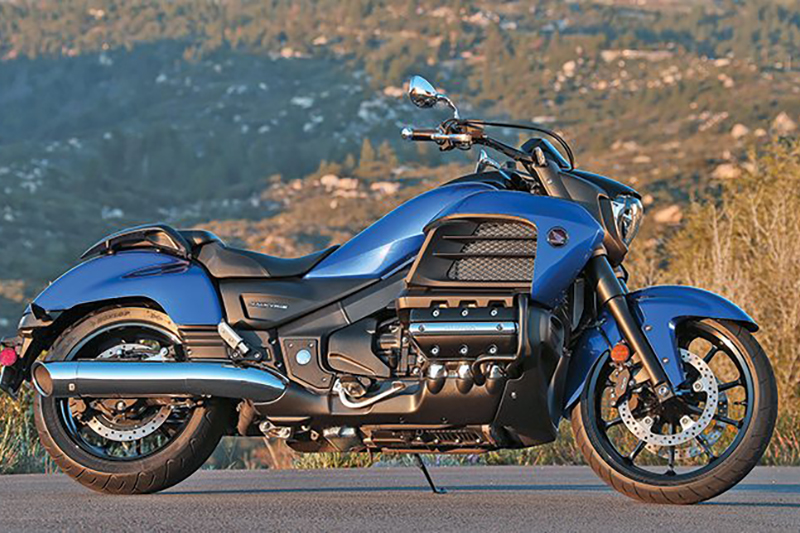2014 Honda Valkyrie

Road Test Review
As many Gold Wing and F6B riders know, a motorcycle with Honda’s GL1800 flat six at its heart can be ridden smoothly and quietly, like a luxury automobile, or blasted up and down through the gears with snarling gusto. It’s a big, versatile gem of a powerplant—one reason that Honda has based a variety of models on it.
The latest is the 2014 Valkyrie cruiser, the first six with a feature that gets as much attention as the engine—its polarizing styling. Honda is throwing all kinds of designs at the wall lately—retro, crossover, techno, economical, futuristic—a good thing for the market even if they don’t all stick. In the Valkyrie’s case, its look is obviously aimed at the non-traditional cruiser rider, one who is perhaps a bit younger and wants something really different with some genuine performance. It won’t be mistaken for any other cruiser, not even the 1997 Valkyrie, that’s for sure.
With the introduction of the 2001 Gold Wing, Honda’s iconic flat six grew from 1,520cc to 1,832cc. Though it’s no longer the most powerful six-pack in touring land, its overall output bests every other cruiser save the Star Vmax and humongous Triumph Rocket III Roadster. The only real change to the fuel-injected, liquid-cooled SOHC mill with two valves per cylinder for the Valky is to the dual exhaust, which is shorter, lighter and belts out a deeper, more James Earl Jones note from its slash-cut tips. It and a slightly different airbox seem to help the bike make about five percent more power—on the Jett Tuning dyno the Valkyrie revved up 104.8 horsepower at 5,600 rpm and 112.4 lb-ft of torque at 4,000, with a monstrous plateau of more than 100 lb-ft of torque on tap from 2,200 to 5,400 rpm. This bike will lug down to idle and pull away smartly…in fifth gear.
Back in 2001, though the engine shrunk overall, the GL1800’s larger displacement required more radiator capacity. Instead of going with less than optimum wheelbase and steering geometry dimensions on the Gold Wing in order to fit a single huge cooling unit in front, Honda split the rad in two and hid the halves under the fairing on each side. This and the Gold Wing’s stout twin-spar aluminum frame and single-sided swingarm helped give it surprisingly good, big sportbike-like handling, which quickly dissipated any controversy over the side-mounted rads. They did create a challenge for the latest Valkyrie’s designers, however, who also wanted to maintain the GL1800 platform’s great handling, but lacked a convenient hiding place for the radiators on the stripped-down machine. The “big shoulders” shrouds that resulted tie-in nicely with the fenders and the bike’s avant-garde muscle-cruiser styling. They also direct hot air away from the rider and provide some lower leg protection.
Some tweaks to the GL’s running gear were necessary to adapt it to performance-cruiser duty. Wheel sizes front and rear were increased one inch for more cornering clearance, so the fork had to be a bit longer even though the bike runs slightly lower-profile 130/60-19 and 180/55-17 tires. The resulting changes to the steering geometry are minimal—wheelbase has grown 0.5 inch, rake less than 0.5 degree and trail 0.2 inch over the F6B/Gold Wing. The rear subframe was changed to accommodate the Valky’s unique seating arrangement, and seat height is right in the middle at 28.8 inches. The 6.0-gallon gas tank is the steel real deal, too—there’s no fuel hiding under the seat as on the other GL1800s. Yet, overall, the bike still has the chassis formula that makes the Gold Wing and F6B rock-stable on the highway and so ridiculously capable in the corners.
And get this—at 746 pounds fully fueled the Valkyrie weighs about 90 pounds less than the F6B, and is 154 pounds lighter than the Wing. If you like this engine, the Valky’s much improved power-to-weight ratio is the best way to experience it. Fire the big bike up with a roar from the more open exhaust and it pulls away strongly without hesitation, practically begging you to jump on the throttle. The bike’s lighter weight makes the big GL engine feel especially alive, and its broad spread of earth-moving torque and smoothness accelerate the bike like a rocket. It can be left in third gear and ridden briskly in the corners thanks to its good cornering clearance, and since all three GL1800s have the same gear ratios, top fifth gear on the highway delivers the same smooth flagship touring manners, with buckets of power in reserve for passing and such. It’s still a cruiserish experience, but sounds and feels nothing like the traditional V-twin potato-potato-potato.
The sheer size of the Valkyrie gives it generous seating proportions, with a wide 1-inch pullback handlebar that is slightly wider, taller and farther forward than the F6B’s, and is rubber mounted—zero vibes get through to the rider in the bar, seat or pegs. The low seat is flat and broad, and footpegs are 1.3 inches forward and 0.6-inch higher for a sportier feel and more cornering clearance, as well. The instrument cluster, headlight surround, radiator shrouds and cylinder heads provide some lower-body wind protection, but your upper body is in the wind and all of your weight is on the firm seat, so long highway rides can become tiresome. Passengers have it pretty good, with a reasonably sized pillion and ample grab rails, both of which can be removed for a solo look. Among the 15 accessories for the Valkyrie are Boulevard and Tall windscreens, a wind deflector, backrest and passenger floorboards, as well as saddlebags and a rear carrier, so you can easily enhance its touring comfort and capacity.
The Valkyrie’s suspension has the same good travel front and rear as the Gold Wing and F6B, with damping that Honda says is calibrated for the lighter machine. It is significantly firmer than either of those bikes, great for more aggressive riding but a bit jarring over bumps. The cartridge fork has no adjustments, though the rear Pro-Link shock offers remote spring preload adjustment similar to the F6B’s. This bike also gets more stopping power to suit its sportier intent, with dual opposed 4-piston calipers up front with floating 310mm rotors that are larger than the Wing’s/F6B’s 296mm discs. A 2-piston floating caliper grabs the 316mm disc in back. On the Black bike, ABS is a $1,000 option, adds just six pounds and brings with it self-canceling turn signals. Both the standard and ABS-braked machines stop incredibly well, with great feel at the lever and pedal and just a slight clicking sensation in either when ABS is engaged.
Nice stuff includes an LED headlight, taillight and turn signals, and a cool-looking multi-function digital LCD instrument display with a customizable start-up message. On the Blue Metallic bike, several components such as the fork, tank nacelle, grab rails and engine covers are menacingly blacked-out; on the gorgeous Dark Red Metallic and Black Valkys those bits are chrome or silver. There’s a large locking storage compartment under the right side panel, and a thoughtful pair of guards to protect the engine in a tipover. Everything you need, nothing you don’t.
Photographs don’t do justice to the Valkyrie’s styling, which usually wins over even hard-core traditionalists when they see it in the metal. And if that doesn’t do it, one ride definitely will. It’s fast, comfortable, stops unbelievably well and sounds righteous, a 6-cylinder cruiser that shakes the custom paradigm to the core, just like the original. Only different.
